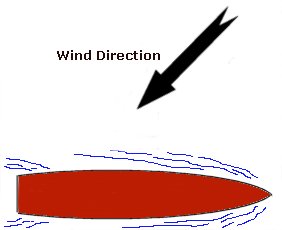RC sailboats are the most peaceful way to enjoy radio control boating, but in a way are also the hardest rc boats to master - with a nitro or electric model boat you can just open the throttle and blast round the lake, but sailing a boat that relies solely on the wind does require some basic knowledge about how to use the wind to its maximum effect.
The four most common terms that are used by sailors are reaching, running,beating and tacking.
Below are some pictures of these methods, below each one is a small description of what's happening:
Below are some pictures of these methods, below each one is a small description of what's happening:
Reaching
Reaching is the term used when the boat is at 90 degrees, or side-on, to the wind.
The term 'reaching', however, can be broken down into 3 further terms;
close reach is when the wind is blowing at a 3/4 angle to the bow of the boat;
beam reach is when the wind is blowing at exactly right angles to the boat and
broad reach is when the wind is blowing at a 3/4 angle to the stern of the boat.
close reach is when the wind is blowing at a 3/4 angle to the bow of the boat;
beam reach is when the wind is blowing at exactly right angles to the boat and
broad reach is when the wind is blowing at a 3/4 angle to the stern of the boat.

Running
Running is the term used when the boat is being sailed in the same direction as the wind ie the wind is blowing directly to the stern of the boat.

Beating
Beating is the term used when the boat is sailing as much into the wind as it can get.

Tacking
The term tacking is used to describe the line that a sailor sails his boat to make progress into wind.
Tacking is a continuous zig-zagging at approximately 45 degrees into wind on each tack. As it's impossible for a sailboat to sail directly into the wind, this is the most efficient way of making headway.
Tacking is a continuous zig-zagging at approximately 45 degrees into wind on each tack. As it's impossible for a sailboat to sail directly into the wind, this is the most efficient way of making headway.








